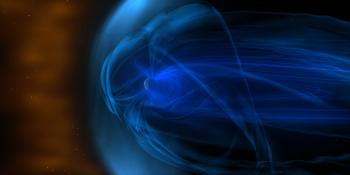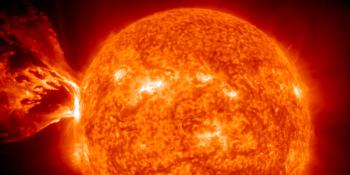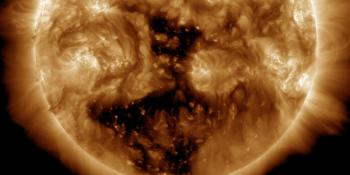SIDC igapäevane bülletään päikese ja geomagnetilise aktiivsuse kohta
Välja antud: 2025 May 12 1231 UTC
SIDC ennustus
Päikesepursked ehk loited
C-class flares expected, (probability >=50%)
Geomagnetism
Quiet (A<20 and K<4)
Päikese prootonid
Quiet
| 10 cm vool | Ap | |
|---|---|---|
| 12 May 2025 | 123 | 007 |
| 13 May 2025 | 121 | 007 |
| 14 May 2025 | 119 | 007 |
Päikese aktiivsed piirkonnad ja pursked
Solar flaring activity was moderate over the past 24 hours, with one M-class flare and a few C-class flares. The strongest flare was a M1.9 flare (SIDC Flare 4368) peaking at 00:01 UTC on May 12, from beyond the west limb. There are currently five numbered active regions on the solar disk. SIDC Sunspot Groups 450, 490, 492, 494 (NOAA Active Regions 4085, 4081, 4082, 4086) are the most complex ones, all with magnetic type beta. SIDC Sunspot Group 469 (NOAA Active Region 4079) has rotated behind the west limb. The solar flaring activity is expected to be low over the next 24 hours, with C-class flares expected and a small chance for M-class flares.
Krooniaine massiline väljavool
A wide, faint Coronal Mass Ejection (CME) was observed in LASCO/C2 and LASCO/C3 coronagraph imagery starting from around 20:00 UTC on May 11, lifting of the northwest limb. No clear source was identified on the visible disk, suggesting a backsided event that will not impact Earth. A prominence eruption was observed in AIA 304 data around 21:00 UTC on May 11, in the east limb. A very narrow associated CME was observed in LASCO/C2 coronagraph imagery around 22:00 UTC on May 11. It is not expected to impact Earth. No other Earth-directed CMEs were observed in the available coronagraph imagery.
Krooniauk
A small, equatorial, negative polarity coronal hole, SIDC Coronal Hole 114, is crossing the central meridian. An associated high- speed stream may arrive at Earth starting from May 15.
Päikesetuul
The solar wind conditions (ACE and DSCOVR) are gradually returning to the slow solar wind regime, under the waning influence of the high-speed stream from the southern, negative polarity coronal hole (SIDC Coronal Hole 113). Speed values ranged between 400 km/s and 470 km/s. The interplanetary magnetic field values were between 5 nT and 11 nT. The Bz component varied between -8 nT and 10 nT. The interplanetary magnetic field angle was mostly in the negative sector. Currently, speed values are around 390 km/s and the interplanetary magnetic field around 8 nT. Slow solar wind conditions are expected over the next 24 hours.
Geomagnetism
Geomagnetic conditions globally reached minor storm conditions (NOAA Kp 5-) between 18:00 UTC and 21:00 UTC on May 11. Geomagnetic conditions locally were mostly at unsettled levels (K BEL 3) and reached active levels (K BEL 4) between 20:00 UTC and 23:00 UTC on May 11. Geomagnetic conditions globally and locally have currently returned to quiet levels (NOAA Kp 2 and K BEL 2). Mostly quiet conditions are expected globally and locally over the next 24 hours.
Prootoni voo tasemed
The greater than 10 MeV proton flux was below the threshold level over the past 24 hours. It is expected to remain below the threshold level over the next 24 hours, pending no further eruptive activity.
Elektronivoog geostatsionaarsel orbiidil
The greater than 2 MeV electron flux measured by GOES 18 was above the threshold between 18:15 UTC and 22:45 UTC on May 11. The greater than 2 MeV electron flux measured by GOES 19 was enhanced but remained below the threshold in the last 24 hours. The 24-hour electron fluence is presently at normal levels and is expected to remain so over the next 24 hours.
Tänane hinnanguline rahvusvaheline päikeselaikude arv (ISN): 065, põhineb 20 jaamadel.Päikese indeksid 11 May 2025
| Catania Wolfi number | /// |
| 10cm päikesevoog | 126 |
| AK Chambon La Forêt | 021 |
| AK Wingst | 019 |
| Hinnanguline Ap | 018 |
| Hinnanguline rahvusvaheline päikeselaikude arv | 072 - Põhineb 25 jaamal |
Märkimisväärsete sündmuste kokkuvõte
| Päev | Algus | Maks | Lõpp | Lokatsioon | Tugevus | OP | 10cm | Catania/NOAA | Raadiosignaalipursete tüübid |
|---|---|---|---|---|---|---|---|---|---|
| 11 | 2355 | 0001 | 0006 | ---- | M1.9 | 56/4079 |
Andmed on esitanud Päikeseinfektide Andmeanalüüsi Keskus (Solar Influences Data Analysis Center)© - SIDC - Töötleb SpaceWeatherLive
Viimane uudis
Viimane foorumi postitus
Toeta SpaceWeatherLive.com-i!
Paljud inimesed külastavad SpaceWeatherLive lehte selleks, et jälgida, mis toimub Päikesel või, kas on oodata virmalisi. Suurema liiklusega on serveri koormus ning maksumus kõrgem. Kui sulle meeldib see, mida me sinu heaks teeme, siis saad sa sellele ka ise natukene kaasa aidata, annetades selle lehe käigus hoidmise ja arendamise heaks. Ette tänades SpeaceWeatherLive meeskond!

Fakte kosmose ilmast
| Viimane X-loide | 28/03/2025 | X1.1 |
| Viimane M-loide | 12/05/2025 | M1.9 |
| Viimane geomagnetiline torm | 03/05/2025 | Kp5 (G1) |
| Plekivabasid päevi | |
|---|---|
| Viimane päikese plekivaba päev | 08/06/2022 |
| Kuu keskmine päikeseplekkide arv | |
|---|---|
| aprill 2025 | 140.6 +6.4 |
| mai 2025 | 76.7 -63.9 |
| Viimased 30 päeva | 100.9 -32 |


